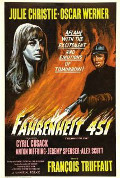
Directed by
Francois Truffaut
112 minutes
Rated PG
Reviewed by
Bernard Hemingway

Fahrenheit 451
Jean-Luc Godard would no doubt have taken Ray Bradbury’s sci-fi novel of the same name and placarded it with political provocation but Truffaut gives it a romanticized treatment (although the spoken opening credits are suggestive of Godard) in what was his first and only English-language project. It was made aslo with an English crew as well as the director's first film in colour and one heavily dependent on studio interiors. As Pauline Kael pointed out, Bradbury’s novel was not much more than a gimmicky idea in the first place (the film’s title refers to the temperature at which paper burns) and Truffaut’s largely faithful translation of it only serves to emphasize its simplistic nature.
Set in the near future it tells of a society in which books are banned by a totalitarian regime and the story of Montag, one of the regime’s book-burning fireman (Oskar Werner, star of Truffaut’s most famous film, Jules And Jim, 1961) who becomes involved with an underground resistance group who have dedicated themselves to each memorizing a literary work. Julie Christie plays two roles as Linda, Montag’s conformist wife, and Clarisse, a member of the resistance group.
Despite the fact that Truffaut was so enthusiastic to do the film that he started production without a script, it is generally regarded as mis-fire for him (Truffaut who also wrote the screenplay with Jean-Louis Richard, did not speak English and, understandably, preferred the French dubbed version), lacking his characteristic wit and spontaneity. The double role for Christie, a last minute and questionable (Montag doesn't even comment on the remarkable resemblance) decision, caused Terence Stamp who had originally been given the role of Montag to pull out. He needn't have bothered as Christie is unimpressive in both roles (they appeared together the following year in Far From The Madding Crowd). His replacement, Oskar Werner, fell out badly with Truffaut during filming. Little surprise that the film did not come off.
If the film doesn't work dramatically it does have a certain cabinet value for its very 60s modernist vision of the future (one thing they got impressively right was the large flat screen TVs). Nicolas Roeg's cinematography gives the Thunderbird-ish production design (the groovy exterior monorail scenes were shot at the SAFEGE test track, in Châteauneuf-sur-Loire near Orléans in France) a glossy, sharp edged sheen amply helped out by the art direction, wardrobe design and set decoration.
The score was by Bernard Hermann, well-known for his work with Hitchcock, one of Truffaut's favourite directors, although it was Bradbury who came up with the idea of using him.
Want something different?





